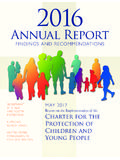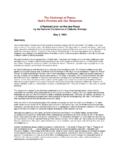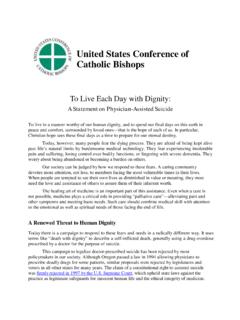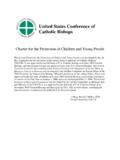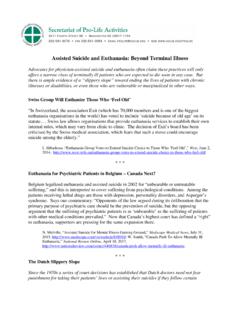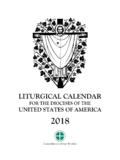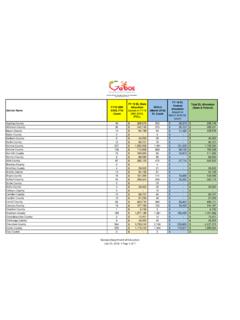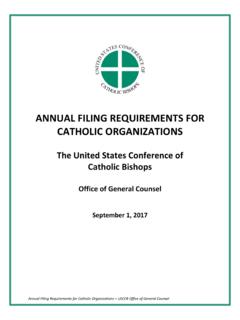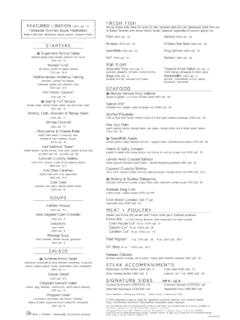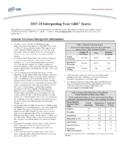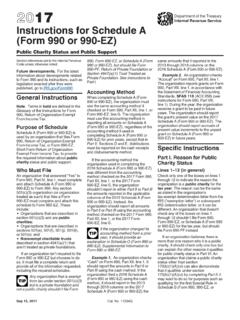Transcription of ANNUAL FILING REQUIREMENTS FOR CATHOLIC …
1 ANNUAL FILING REQUIREMENTS FOR. CATHOLIC ORGANIZATIONS. The United States Conference of CATHOLIC Bishops Office of General Counsel March 1, 2015. ANNUAL FILING REQUIREMENTS for CATHOLIC Organizations USCCB Office of General Counsel These guidelines do not constitute legal advice. They are provided for information purposes only. Whether an organization is required to file an ANNUAL information return (Form 990, 990-EZ, 990-N or 990-PF) is a facts-and-circumstances determination. Organizations are strongly advised to consult with a tax advisor regarding their FILING REQUIREMENTS . Table of Contents ANNUAL FILING REQUIREMENTS for CATHOLIC Organizations INTRODUCTION AND PURPOSE .. 1. HISTORY AND BACKGROUND OF ANNUAL REPORTING REQUIREMENTS .. 2. Terminology ..2. History and Background ..2. CATHOLIC Organizations in the Group Ruling.
2 3. FILING EXEMPTIONS .. 3. Churches and Conventions or Associations of Churches ..3. Example: Parish and Parish 4. Example: Parish and Separately Incorporated Parish School .. 4. Example: Diocese and Diocesan Support organization .. 4. Example: Diocese and Single Member Limited Liability Company .. 5. Disregarded Entities .. 5. Example: Dioceses and State CATHOLIC Conference .. 6. Example: Dioceses and Separately Incorporated State CATHOLIC Conference .. 6. Schools Affiliated with a Church or Operated by a Religious Order ..6. Racial Nondiscrimination Policy .. 7. Statement of Nondiscriminatory Policy .. 8. ANNUAL Publication of the Policy .. 8. ANNUAL Certification of the Policy and 9. Integrated Auxiliaries ..9. Described Both in Sections 501(c)(3) and 509(a)(1), (2), or (3) .. 9. Affiliated with a Church or a Convention or Association of Churches.
3 10. Internally Supported .. 10. Men's and Women's Organizations, Seminaries, Mission Societies and Youth Groups .. 11. Exclusively Religious Activities of any Religious Order ..11. Example: Religious Order and Separately Incorporated 12. Example: Religious Order and Separate Welfare Trust .. 12. FILING 12. Form 990, Form 990-EZ or Form 990-N? ..12. Gross Receipts .. 13. Normally Not More Than .. 13. Neither a Private Foundation Nor a Supporting organization .. 13. Supporting Organizations Eligible to File Form 990-N .. 14. Form 990 or Form 990-EZ?.. 14. Chart Summary of Form 990/EZ/N FILING Thresholds .. 15. Group Returns ..15. Chart of Public Charity Classification and FILING Requirement ..16. Due Date for FILING Form 990/EZ/N ..17. When does a CATHOLIC organization need to begin FILING Form 990/EZ/N?
4 17. Public Inspection REQUIREMENTS ..18. Public Inspection of Form 990/EZ/N .. 18. Public Inspection of Form 0928A, Application for Inclusion in Group Ruling .. 18. CONSEQUENCES OF NOT FILING ; AUTO-REVOCATION .. 18. Nonfiler Penalties ..19. Auto-Revocation ..19. Example: Auto-Revocation .. 20. Erroneous Notices of Non- FILING or Auto-Revocation .. 20. INTRODUCTION AND PURPOSE. The USCCB Office of General Counsel is providing these guidelines to (arch)dioceses, parishes, and other CATHOLIC organizations ( CATHOLIC organizations ) exempt from federal income tax under section 501(a) of the Internal Revenue Code ( Code )1 and described in section 501(c)(3). to assist them in understanding their ANNUAL reporting REQUIREMENTS under section 6033. The guidelines are intended for CATHOLIC organizations included in the USCCB group ruling.
5 The USCCB group ruling is sometimes referred to as GEN 0928, because of its designation in IRS. records. GEN refers to Group Exemption Number. ( GEN 0928 ). These guidelines discuss which organizations are exempt from having to file an ANNUAL information return or electronic notice, and if an organization is required to file an ANNUAL information return or electronic notice, which form it should file ( , Form 990, Form 990-EZ or Form 990-N). There is a misunderstanding that organizations included in a church group ruling do not have to file a Form 990, Form 990-EZ or Form 990-N. This has not been true for approximately forty years. 2 Generally, all CATHOLIC organizations are required to file annually a Form 990, Form 990- EZ or Form 990-N unless exempted by a specific statutory or regulatory provision.
6 Generally, only dioceses, parishes, schools below college level, and provinces of religious institutes (but not their affiliated ministries) can claim exemption from having to file a Form 990, Form 990-EZ. or Form 990-N, unless the organization can properly be classified as an integrated auxiliary of a church. The term integrated auxiliary is also somewhat misunderstood. As explained in Integrated Auxiliaries, below, whether a CATHOLIC organization included in the group ruling qualifies as an integrated auxiliary ultimately depends on an objective analysis of the nature of the organization 's activities as they relate to the public rather than a subjective determination of the degree of relatedness to or control by another church organization . Because all organizations that are eligible for inclusion in the USCCB group ruling will satisfy the first two of the three prongs of the test for integrated auxiliary status, the relational or affiliation requirement for integrated auxiliary status will be met by all group ruling organizations.
7 Additional relational factors, such as whether and to what extent an organization is controlled by an affiliated parish, diocese or religious institute, or the composition of an organization 's board of directors, are irrelevant. These guidelines also address the requirement that CATHOLIC schools (elementary, high school and college) adopt a racial nondiscrimination policy, operate in accordance with that policy, make it known to all segments of the general community served by the school, and certify annually that they meet the REQUIREMENTS of Revenue Procedure 75-50 by FILING Form 5578, 1. All references herein are to the Internal Revenue Code of 1986, as amended, unless otherwise indicated. 2. The IRS exercised its discretion to exempt organizations included in church group rulings until 1975.
8 ANNUAL FILING REQUIREMENTS for CATHOLIC Organizations USCCB Office of General Counsel ANNUAL Certification of Racial Nondiscrimination for a Private School Exempt From Federal Income Tax. These guidelines do not address other ANNUAL or periodic reporting REQUIREMENTS that may apply to CATHOLIC organizations or their officers, directors, trustees or employees, including but not limited to Form 990-T, Exempt organization Business Income Tax Return, Form 941, Employer's Quarterly Federal Tax Return, or FinCEN Form 114, Report of Foreign Bank and Financial Accounts (FBAR). HISTORY AND BACKGROUND OF ANNUAL REPORTING REQUIREMENTS . Terminology Form 990, Return of organization Exempt From Income Tax, is an information return, as distinguished from an income tax return. Form 990-EZ, Short Form Return of organization Exempt from Income Tax, is also an information return.
9 Organizations do not report or pay tax with a Form 990 or Form 990-EZ. Form 990-N (sometimes referred to as the e-Postcard) is a notice, not signed under penalties of perjury, and requires significantly less information from the FILING organization than an information return. 3 For purposes of these guidelines, when referring to all three forms or a requirement that is applicable to all three forms, the term ANNUAL information returns or ANNUAL information return will be used, or the applicable form(s) will be referred to, , Form 990/EZ, or Form 990/EZ/N, or Form 990-N. Form 990-T, Exempt organization Business Income Tax Return, is an income tax return. History and Background Tax exemption under section 501(a) and eligibility to receive income tax deductible charitable contributions under section 170(c) are a form of tax subsidy authorized by Congress in the Internal Revenue The statutory requirement for tax-exempt organizations to file reports with the IRS, coupled with statutory provisions regarding public inspection of such reports, permits the IRS and the public to ensure that an organization 's tax subsidy is warranted and that the organization is complying with federal tax laws.
10 Congress first began requiring tax-exempt organizations to file information returns in 1943, seven years before tax-exempt organizations were required to report and pay tax on their unrelated business taxable income. Until 1969, Congress provided a broad exemption from the information return FILING requirement in section 6033(a) for any religious organization described in section 501(c)(3) [or] organization described in section 501(c)(3), if operated, supervised, or controlled by or in connection with [such] a religious organization . As part of the Tax Reform Act of 1969, however, Congress eliminated the broad FILING exemption for religious organizations and replaced it with a more narrow exemption for churches, their 3. See Section 6033(i). 4. Regan v. Taxation with Representation of Washington, 461 540, 544 (1983).
